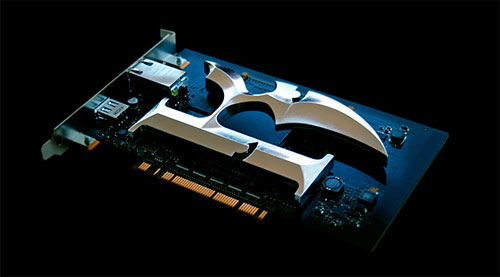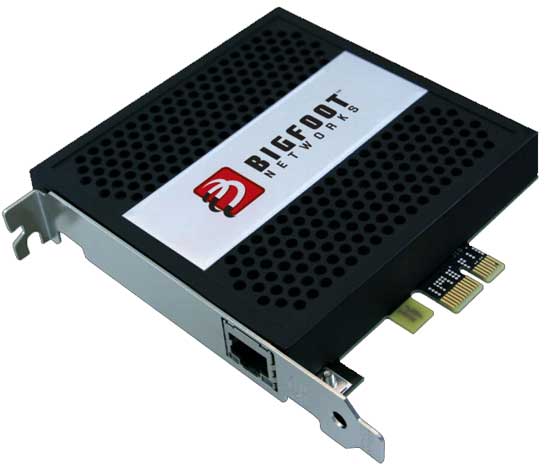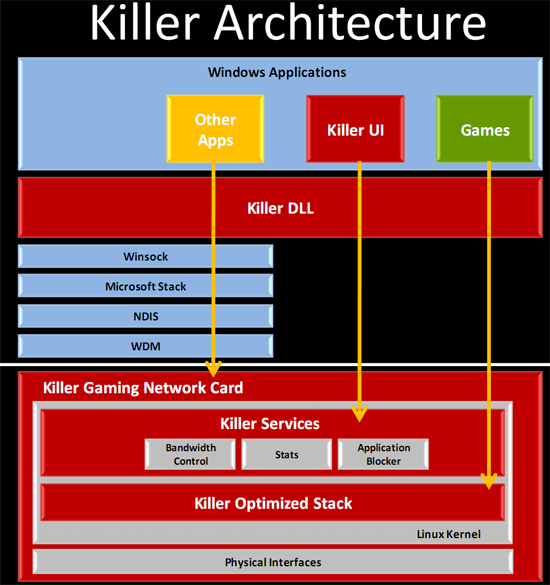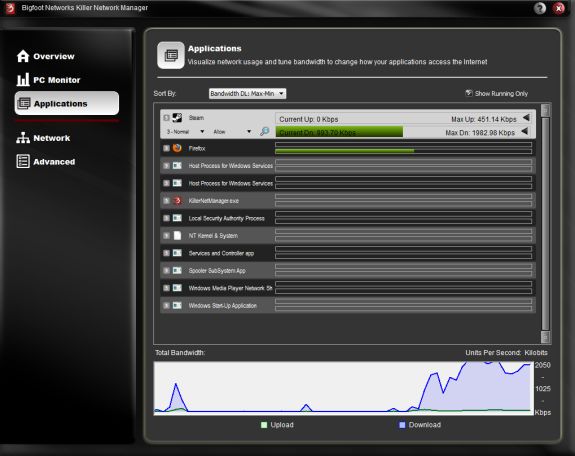Bigfoot Networks Announces 3rd Gen Killer NIC: Killer 2100
by Ryan Smith on May 11, 2010 12:01 AM EST- Posted in
- Networking
- Killer
- NIC
Back in 2006, technology newcomer Bigfoot Networks announced the Killer NIC, an unusual network interface card targeted at the high-end gaming market. With this coming fairly shortly after solid consumer-grade NICs became universally integrated in to motherboards, the timing wasn’t the best. At $280, neither was the price.
The Killer NIC marked a sort of return to the idea of a complex NIC, forgoing a simple controller/PHY combination in favor of a complex dedicated device capable of acting more independently. By endowing a NIC with a full-fledged microcomputer running Linux, not only could the card offload virtually every part of processing required for network operations, but it could even bypass Windows’ notorious networking stack and handle packets in a manner better suited for low-latency use (i.e. games). In turn the Killer NIC would be able offer lower and more stable pings than standard NICs, and with lower CPU overhead increase game/application performance too.

The original Killer NIC in 2006
The reality of the hardware didn’t quite live up to the initial hype. In our review of the original Killer NIC the results were a mixed bag: offloading did improve game performance slightly in CPU-limited situations, but we couldn’t find any significant improvements to ping/latency in games. Ultimately any benefits the card could offer couldn’t justify the $280 price tag even among the high-spending gaming crowd. Later in 2009 they released their second-generation Killer Xeno Pro, but even with a lower price the results were much of the same.
Flash forward to today and Bigfoot Networks has continued their product development unabated, bringing us to their latest product: the Killer 2100. The 2100 is Bigfoot’s 3rd generation Killer NIC, and will be replacing the Killer Xeno Pro. We will be reviewing the card next week when our sample arrives, but ahead of that we wanted to do a quick rundown of what we know thus far after talking to Bigfoot.

The Killer 2100
Let’s start with the hardware:
- 10/100/1000 Ethernet
- PCIe x1 interface
- 400MHz dedicated network processor (PowerPC)
- 128MB DDR2 RAM
Bigfoot tells us that the Killer 2100 hardware isn’t significantly different from the current Killer Xeno Pro. The biggest change is that Bigfoot has ditched all non-Ethernet functionality, dropping the USB port and the 3.5mm audio jacks, leaving only the RJ-45 port. Internally hardware is largely the same. The network processor continues to be an embedded PowerPC CPU, which was likely chosen for PowerPC’s big endian support.
As the hardware is being left relatively unchanged, the significant introduction for the Killer 2100 is the software stack, which Bigfoot is telling us had a major overhaul. As you may recall the entire Killer NIC line runs an embedded Linux distribution on the NIC, so in this case a software overhaul means upgrading both the embedded Linux distribution and the end-user Windows software.
Bigfoot hasn’t told us much about what they’ve done on the Linux side of things, although they are calling it a whole new architecture. In any case the fundamentals of the Killer NIC haven’t changed – it’s still based around bypassing the Windows networking stack on low-latency applications – with features such as application prioritization, offloading, and shaping/throttling bringing up the rear. The biggest low-level change we do know about is that Bigfoot has done something about the Killer Xeno Pro’s previously poor throughput, which means that the Killer 2100 should now be competitive at GigE speeds when operating on a LAN.

Beyond the usual optimizations, the bulk of the other changes are to the end-user software. Late last year Bigfoot introduced a new utility called Dashboard that augmented the Killer Xeno’s basic control panel with a more advanced graphical readout of the card’s status. The Killer 2100 is going to take this all the way, giving the Dashboard (now the Killer Network Manager) greater control over the card. This culminates in a new feature they are calling Visual Bandwidth Control, which in a nutshell is a graphical readout of each application’s bandwidth usage in order to see what each application is using and being able to set bandwidth throttles accordingly. Throttling itself isn’t new, but being able to visualize per-application usage from the NIC is, and is the cornerstone of what they’re calling their key breakthrough – allowing the user to better monitor the card.
Along with this, Bigfoot is also rolling out a new NIC benchmark they are calling Gaming Network Efficiency (GaNE). This is intended to solve one of Bigfoot’s biggest issues in selling the card – being able to showcase the difference in a reliable manner. Although we’re always leery of vendor-provided benchmarks, Bigfoot has offered us the source code to GaNE and we’ll be looking at it once our sample arrives to see if there’s anything to it.
GaNE also marks a bit of a shift in how Bigfoot will be marketing the Killer lineup. In their meeting with us, less of an emphasis was placed on total latency in favor of network jitter (which GaNE can conveniently benchmark). Bigfoot claims that the Killer 2100 has much less jitter than standard NICs, which would serve to keep latency more stable and avoid triggering undesired responses from games that believe that latency is spiking. Bigfoot still believes that the Killer 2100 will offer better latency through the combination of better jitter and their own optimizations towards latency by reducing buffering where applicable, but it’s certainly a more realistic approach than focusing solely on latency, something that’s largely out of the NIC’s hands in the first place. All of this we will of course be testing to see how truthful it is and what impact it actually has.
Finally, we’ll wrap up this announcement with some good news for existing Killer Xeno Pro owners. Since the hardware is largely unchanged, Bigfoot will be releasing a version of their new software stack for the Xeno Pro, giving it most of the functionality of the Killer 2100. Ultimately any future improvements to their software will be reserved for the Killer 2100, but this is an appropriate gesture given the short time of under a year between the launch of the Killer Xeno Pro and the Killer 2100.
The Killer 2100 will be selling at the same $129 price as the existing Killer Xeno Pro, cementing its spot as the Xeno Pro’s replacement. Bigfoot’s official press release leaves the actual availability date open with a simple “coming weeks”, although for North American distribution it sounds like it could show up as early as this week.
We’ll have more on the Killer 2100 in our full review next week, so stay tuned.











78 Comments
View All Comments
Focher - Tuesday, May 11, 2010 - link
I just don't understand how they are still in this business. This will be their - what? - third generation card? Each time, reviews have clearly shown that the cards give essentially no performance benefit in real world situations. It's a NIC designed for total geeks. The specs look great on paper, but don't deliver any practical value.The conversation about how the card looks versus what it can do reinforces how far down the rabbit hole we're getting.
afkrotch - Tuesday, May 11, 2010 - link
For a regular home user, sure the card is a whole lot of worthless. Not going to get much benefit over a standard onboard nic.v12v12 - Wednesday, May 12, 2010 - link
I agree... I don't see how this "business" stays in biz; they probably do 3rd party work for other corps/businesses; it's how AMD manages to stay afloat in the CPU desk-top market....Still, who goes out and buys one of these things w/o already having a pretty expensive/maxed out rig? SSD, SLI/CF, i7/X6/DDR3/RAID 0+1 etc...
Haha might as well just spend that money on a line upgrade from your ISP?!
dagamer34 - Tuesday, May 11, 2010 - link
If you're interested in this network card, I have some dark fiber in Alaska I'd like to sell you...imaheadcase - Tuesday, May 11, 2010 - link
I like how they put "our tests show". /laughThey most have a great pitch team to put to investors is all i can say.
Seriously lets break it down for you..
1. Same card as before.
2. claim to re-due code for card, without actually being able to show what they changed. AMAZING. Could be the exact same thing as before.
3. took things OFF the card saying they was not needed. Like that did not occur to them before?
Want to get a better internet connection/download/latency? STOP PLAYING ON SERVERS IN CHINA WITH GAMES.
You can't fix internet congestion/problems with a network card people. BigFoot Networks is just making a useless product for people who don't know any better.
Whats next Bigfoot Networks? Going to release a keyboard with a dedicated 1ghz CPU in it to support awesome features the ability to switch from a normal keyboard to a gaming keyboard? /sarcasm
HangFire - Wednesday, May 12, 2010 - link
Lowering latency between the card and the application, and reducing CPU utilization, have always been their sales pitch. Lowering network latency is simply an IP prioritization feature that most cards have and not all networks honour.Still, some folks like to bash it for what it can't do, and what it doesn't claim to do, so if it makes you feel better...
...and no, I don't own one.
Necrosaro420 - Tuesday, May 11, 2010 - link
I get max speeds (30 meg line) already with a $30 linksys, whats this thing do that a linksys card dont?Arrakiv - Thursday, May 13, 2010 - link
You get your full throughput with the $30 linksys... You don't get max latency.Latency and throughput aren't the same thing. One is a measure of how much data you're receiving at once, one is a measure of how quickly those packets are actually coming in. A packet from your machine to a server, regardless if it is on a 30meg or 15 meg connection, will still go as 'fast' (latency) between your machine and the sever. The benefit of the 30meg connection isn't that packets go faster, just that you're having more coming and going at any one time, which is why you'll get a higher download speed.
For file transfers, latency is pretty unimportant. For gaming (and VoIP, and video chat, and remote desktoping, and what not), throughput is pretty unimportant.
ciukacz - Wednesday, May 12, 2010 - link
over at cfos.de there are some clear explanations how their software works and they make sense.maybe killer works similarly, but does those things in hardware (that doesn't mean it's better because it is a lower layer so it gets a chance to do something later than software).
i know for sure that:
torrents + gaming - better with prioritisation
torrents + remote desktop - excellent with prioritisation, unusable without it
torrents + browsing - better with prioritisation
and when i say torrents i mean fully saturated 25/1,5 Mbps line (100-200 connections)
jabber - Wednesday, May 12, 2010 - link
Just stop it, have a long think about your life and find something more worthwhile to do with your life.Torrenting TBs of data a month isnt a sign of a life well lived.
It's a life wasted. Doesnt impress anyone.
Find another hobby.